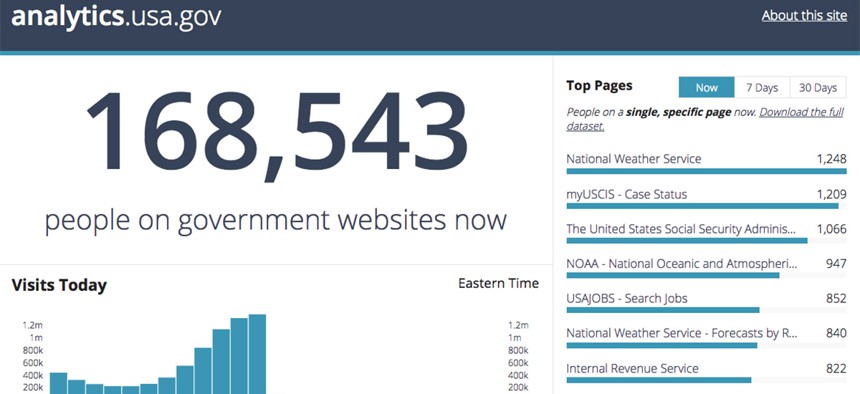Why the Federal Government Tracks Visitors to Dot-Govs

Analytics.usa.gov
Analytics.usa.gov keeps tabs on traffic to more than 4,000 government websites.
For the past several months, the government has been publicly tracking how many visitors come to certain agency websites, and what devices and Web browsers they use to get there.
Analytics.usa.gov, unveiled in March, uses Google Analytics to monitor Web traffic. Earlier this month, the General Services Administration debuted new dashboards showing the general geographic location of visitors to federal sites – 84.6 percent of visitors come from the U.S. and 4.5 percent of that from Washington – and logs showing the most downloaded public documents. Currently the most-clicked is a notification letter from the Office of Personnel and Management alerting victims of the recent cyber hack.
Still, analytics.usa.gov's launch was greeted with concern from some quarters that the government would collect personal information about Web users' browsing behavior, according to Tim Lowden, a program analyst with GSA's Digital Analytics Program, who discussed the Web-tracking efforts at a recent event in Washington.
GSA has since been emphasizing in blog posts that the site anonymizes IP addresses before storing them, and that tracking is currently limited to about 4,000 sites and 400 domains run by about 45 participating federal agencies.
In an email Q&A with Nextgov, Lowden explained why he thinks the tracker -- which could expand to include more tracking dashboards soon -- is useful.
For instance, the Education Department is using it to follow users as they perform specific actions on its site: "If they find that a lot of people exit their site before completing an intended task, they can make site changes accordingly," Lowden wrote. (GSA's press office declined an interview and agreed only to send vetted answers via email to Nextgov.)
Location data, Lowden wrote, is useful to gauging how successful the federal government is in disseminating information. And it has also demonstrated that some federal websites attract significant traffic from international users -- especially the National Library of Medicine.
"I didn’t understand why until I looked at the location data, and found much of their visitors were coming from Spanish-speaking countries," Lowden wrote. "It turns out that nlm.nih.gov, which is similar to WebMD, provides incredibly comprehensive health information in Spanish. If you Google any ailment in Spanish, nlm.nih.gov is the No. 1 result."
Data about what documents users download helps agencies understand which forms and files users are looking for, he wrote.
"The bottom line is that previously, it would be difficult to get reporting from so many agencies and people in order to know that the application for naturalization is the second most downloaded file across 4,000 websites in a particular week," Lowden wrote.
NEXT STORY: Feds Will Require $5 Registration Fee for Drones


